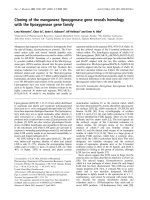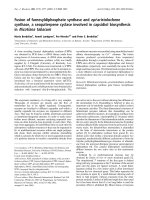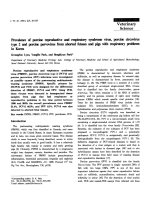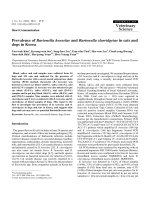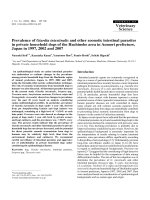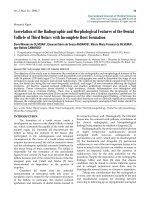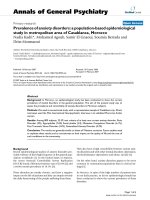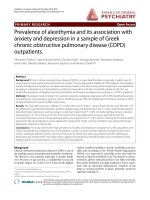Báo cáo y học: ": Prevalence of reverse transcriptase and protease mutations associated with antiretroviral drug resistance among drug-naïve HIV-1 infected pregnant women in Kagera and Kilimanjaro regions, Tanzania" pptx
Bạn đang xem bản rút gọn của tài liệu. Xem và tải ngay bản đầy đủ của tài liệu tại đây (286.6 KB, 9 trang )
BioMed Central
Page 1 of 9
(page number not for citation purposes)
AIDS Research and Therapy
Open Access
Research
Prevalence of reverse transcriptase and protease mutations
associated with antiretroviral drug resistance among drug-naïve
HIV-1 infected pregnant women in Kagera and Kilimanjaro regions,
Tanzania
Balthazar M Nyombi*
1,2,3
, Carol Holm-Hansen
2,4
, Knut I Kristiansen
3
,
Gunnar Bjune
2
and Fredrik Müller
3
Address:
1
Research Laboratory, Kilimanjaro Christian Medical College, Moshi, Tanzania,
2
International Community Health, Institute of General
Practice and Community Medicine, Faculty of Medicine, University of Oslo, Oslo, Norway,
3
Institute of Microbiology, Faculty of Medicine,
University of Oslo and Rikshospitalet University Hospital, Oslo, Norway and
4
Division of Infectious Disease Control, Norwegian Institute of
Public Health, Oslo, Norway
Email: Balthazar M Nyombi* - ; Carol Holm-Hansen - ;
Knut I Kristiansen - ; Gunnar Bjune - ; Fredrik Müller - fredrik.muller@rr-
research.no
* Corresponding author
Abstract
Background: Access to antiretroviral drugs for HIV-1 infection has increased in sub-Saharan
Africa (SSA) during the past few years. Mutations in the HIV-1 genome are often associated with
treatment failure as indicated by viral replication and elevated levels of virus in the blood. Mutations
conferring resistance to antiretroviral drugs are based on comparing gene sequences with
corresponding consensus sequences of HIV-1 subtype B that represents only 10% of the AIDS
pandemic. The HIV pandemic in SSA is characterized by high viral genetic diversity. Before
antiretroviral drugs become more widely available, it is important to characterize baseline naturally
occurring genetic mutations and polymorphisms associated with antiretroviral drug resistance
among circulating HIV-1 subtypes.
Methods: The prevalence of mutations associated with antiretroviral drug resistance in protease
(PR) and reverse transcriptase (RT) regions among antiretroviral treatment-naïve HIV-1 infected
pregnant women was investigated in Bukoba (Kagera) and Moshi (Kilimanjaro) municipalities,
Tanzania, between September and December 2005. The HIV-1 pol gene was amplified using primers
recognizing conserved viral sequences and sequenced employing BigDye chemistry from 100 HIV-
1 seropositive treatment-naïve pregnant women and 61 HIV-1 seropositive women who had
received a single dose of Nevirapine (sdNVP). Positions 1–350 of the RT and 1–99 of the PR genes
were analyzed for mutations based on the Stanford University HIV Drug Resistance Database.
Results: HIV-1 subtypes A, C, D, CRF10_CD and Unique Recombinant Forms (URF) were
detected. Primary mutations associated with NRTI and NNRTI resistance were detected among
3% and 4% of treatment-naïve strains, respectively. Primary mutations associated with NRTI and
NNRTI resistance were detected in 1.6% and 11.5% of women who had received sdNVP,
respectively. None of the primary mutations associated with PI resistance was found.
Published: 21 June 2008
AIDS Research and Therapy 2008, 5:13 doi:10.1186/1742-6405-5-13
Received: 20 February 2008
Accepted: 21 June 2008
This article is available from: />© 2008 Nyombi et al; licensee BioMed Central Ltd.
This is an Open Access article distributed under the terms of the Creative Commons Attribution License ( />),
which permits unrestricted use, distribution, and reproduction in any medium, provided the original work is properly cited.
AIDS Research and Therapy 2008, 5:13 />Page 2 of 9
(page number not for citation purposes)
Polymorphisms detected in RT and PR sequences were mainly mutations that are found in the
consensus sequences of non-B subtypes
Conclusion: Based on the WHO HIV Drug Resistance Research Network Threshold of less than
5%, the baseline prevalence of primary mutations among treatment-naïve HIV-1 infected pregnant
women in Kagera and Kilimanjaro regions was low. The significance of HIV-1 subtype B
polymorphic positions with respect to antiretroviral resistance identified among the prevalent HIV-
1 subtypes is unknown. More studies addressing the correlation between polymorphic mutations,
antiretroviral resistance and clinical outcome are warranted in regions where non-B subtypes are
prevalent.
Background
Tanzania is one of the countries in sub-Saharan Africa
(SSA) most affected by the HIV pandemic. It was esti-
mated that by the end of 2005 approximately 6.5% of
adults throughout the country were living with the virus.
The epidemic is characterized by large differences in the
prevalence and incidence of HIV-1 infections between and
within the regions [1-3]. Kilimanjaro and Kagera have
been among the five regions with the highest prevalence
of HIV-1 infections in Tanzania [4]. Heterosexual trans-
mission accounts for majority of HIV-1 infections and
55% of the reported cases in Tanzania are among women
[4]. Sentinel centres for HIV-1 surveillance were estab-
lished at antenatal clinics (ANC) based on the assumption
that pregnant women attending the clinics constitute an
easily accessible population that represent the sexually
active population at large. A study conducted in Kagera
showed that surveillance of antenatal care pregnant
women as a sentinel population represented the preva-
lence the HIV-1 infections in the general population [5].
A surveillance study performed in 2003/4 indicated that
9.5% and 6.8% of pregnant women attending ANC were
HIV-1 seropositive in Bukoba (Kagera) and Moshi (Kili-
manjaro), respectively [2].
HIV-1 is classified into three phylogenetic groups, main
(M), outlier (O) and non-M, non-O (N). Group M
includes 9 subtypes (A-D, F-H, J and K) and 34 Circulating
Recombinant Forms (CRF) [6,7] that are characterized by
different geographical distributions. The HIV-1 epidemic
in Kilimanjaro and Kagera regions is characterized by sub-
types A, C and D, CRF10_CD and unique recombinant
forms (URF) [8,9]. The great diversity of HIV-1 poses chal-
lenges to accurate viral load determination, the develop-
ment of diagnostic tools and AIDS vaccines, and
monitoring antiretroviral drug resistance [10].
In October 2004 Tanzania initiated a program offering
antiretroviral treatment at no cost to persons with HIV
infection. The treatment includes Triomune, a combina-
tion of two nucleoside reverse transcriptase inhibitors
(NRTI) Stavudine (d4T) and Lamivudine (3TC), and a
non-nucleoside reverse transcriptase inhibitor (NNRTI)
Nevirapine (NVP). WHO estimated that 315,000 persons
living with HIV-1 in Tanzania were eligible for antiretro-
viral drugs in 2005 [11]. The national goal was to provide
antiretroviral therapy to 44,000 HIV-1 infected individu-
als by the end of the same year (National Guidelines for
Clinical Management of HIV and AIDS). The National
AIDS Control Programme (NACP) reported that 19,600
patients were on antiretroviral by the end of 2005. The tar-
get was not reached because few centres were selected to
provide antiretroviral therapy and an insufficient number
of trained health care workers were available to manage
the national care and treatment programme. Gaining
access to antiretroviral drugs has implications for improv-
ing the quality of life for people living with HIV/AIDS, the
prevention of vertical transmission as well as the emer-
gence and transmission of antiretroviral resistant virus
strains [12]. Incomplete adherence to antiretroviral ther-
apy has been documented to be a primary contributing
factor for treatment failure and the development of
antiretroviral resistance among patients in resource-lim-
ited settings [13].
Amino acid mutations in protease (PR) and reverse tran-
scriptase (RT) associated with resistance to antiretroviral
drugs are identified when sequences are compared to the
consesus pol sequence of wild-type HIV
HXB2
. HIV-1 sub-
type B represents 10% of all HIV-1 infections globally [14]
and is most prevalent in developed countries. Single
mutations that confer antiretroviral resistance are known
as "primary mutations" while mutations that must appear
in combination with other mutations are termed "second-
ary mutations" [15]. Over 75% of HIV-1 infections world-
wide are found in SSA, and the numerous local epidemics
in Africa are characterized by diverse circulating non-B
genetic subtypes, CRF and URF [16]. Limited studies have
been conducted in SSA to identify mutations associated
with antiretroviral drug resistance. It is imperative to
investigate and describe mutations associated with resist-
ance to antiretroviral drugs in the RT and PR genes of HIV-
1 non-B subtypes and CRF among treatment-naïve popu-
lations in SSA. Baseline information gained from these
studies will be of importance in the development of algo-
rithms for the interpretation of mutations conferring
AIDS Research and Therapy 2008, 5:13 />Page 3 of 9
(page number not for citation purposes)
antiretroviral drug resistance in different geographical
regions.
The aim of the present study was to report the baseline
prevalence of primary and secondary mutations in PR and
RT that are associated with antiretroviral drug resistance in
treatment-naive pregnant women living in Kagera and
Kilimanjaro regions in Tanzania before extensive use of
antiretroviral drugs is implemented in the country.
Methods
Study subjects and samples
Two hundred forty six HIV-1 infected pregnant women
diagnosed seeking antenatal care and women attending
postnatal care in Bukoba (Kagera) and Moshi (Kiliman-
jaro) municipalities were included in the study. All
women underwent pre- and post-test counselling and
signed informed consent form prior to participating in the
study. Inclusion criteria were: (i) HIV-1 seropositive preg-
nant woman, (ii) pregnant women attending antenatal
clinic (ANC), counselled and enrolled in prevention of
mother-to-child HIV-1 transmission (PMTCT) program,
(iii) not receiving highly active antiretroviral therapy
(HAART), (iv) HIV-1 seropositive women attending post-
natal care, enrolled in PMTCT and received sdNVP, and
(v) signed informed consent form. Blood samples and
demographic information were collected during Septem-
ber to December 2005. Plasma was aliquoted and stored
at -80°C immediately after separation.
HIV-1 serology was performed based on the national HIV
testing algorithm using the two rapid assay confirmatory
strategy for the detection of antibodies to HIV [17]. HIV
antibody testing was performed at the clinics by counsel-
lors using two rapid assays, Capillus (Trinity Biotech, Ire-
land) and Determine (Abbott Laboratories, IL, USA).
Discordant blood samples were sent to the main laborato-
ries in Bukoba (Kagera) or Mawenzi and KCMC (Kiliman-
jaro) for additional testing using ELISA (Vironostika
®
HIV
Uni-Form II Ag/Ab ELISA test; bioMérieux, France).
Plasma samples were shipped on dry ice to the Institute of
Microbiology at Rikshospitalet in Oslo, Norway for fur-
ther laboratory analysis.
The study was reviewed and approved by the KCMC Ethics
Committee (Tanzania) and the Regional Committee for
Ethics in Medical Research (Norway) in compliance with
institutional policies and national guidelines.
Viral load, RNA extraction, RT PCR, secondary PCR and
sequencing
Viral load was determined in 1 ml of plasma using COBAS
AmpliPrep (ROCHE Molecular Systems, Inc. Branchburg,
NJ, USA). HIV-1 RNA was extracted from 1 ml of plasma
using COBAS AmpliPrep Total Nucleic Acid Isolation kit
(ROCHE) or by the method developed by Boom R. et al.
[18] for plasma samples that had volumes less than 1 ml
or viral load below 10,000 particles/ml. RT PCR for the pol
region was performed using the Qiagen One-Step RT PCR
kit (QIAGEN, Valencia, CA, USA) with primer pair
P2073G/P3709. Secondary PCR was performed using
primer pair P2073/P3681 under conditions recom-
mended by the manufacturer. Detailed RT PCR and sec-
ondary PCR parameters are described elsewhere [19].
Ultrapure Water was used as a negative control in each
run.
PCR products were purified using MicroSpin columns (GE
Healthcare BioSciences, Piscataway, NJ, USA). Amplicons
were sequenced employing BigDye chemistry sequence kit
(Applied Biosystems, Foster City, CA, USA.) on an ABI
Prism 3730 DNA sequencer (Applied Biosystems) using
primers P3, P10, P11, P12, P13, P14, P15 and P3681
according to the manufacturer's protocol as previously
described [19].
Generated sequences were assembled using Sequencher
version 4.5 software (Gene Codes Corporation) and the
resulting contig sequences were edited manually. The
sequences were analyzed by bootscan and similarity anal-
ysis using SimPlot version 3.5.1 [20]. Multiple alignments
of the edited sequences with reference sequences from the
HIV sequence database of the Los Alamos National Labo-
ratory were performed using ClustalX [21]. Kimura two-
parameter analysis was applied to calculate the evolution-
ary distance, and phylogenetic trees were constructed
using the neighbour-joining method. Bootstrap values of
100 were used and sequences were gap stripped prior to
tree construction (data not shown). Phylogenetic trees
were viewed using TreeView (Win32) version 1.6.6 (Insti-
tute of Biomedical and Life Science, University of Glas-
gow, UK).
Drug resistance analysis
The edited sequences were submitted to Stanford Univer-
sity HIV Drug Resistance Database and drug resistance
mutation profiles were analysed based on HIVdb: Geno-
typic Resistance Interpretation Algorithm [22].
Statistical methods
A statistical comparison of different group proportions
was made using the Chi square test and Fisher's exact test
when appropriate. Level of significance was set to p ≤
0.05.
Results
Study samples
A total of 161 HIV-1 pol gene sequences, 64 from Bukoba
(Kagera) and 97 from Moshi (Kilimanjaro) were success-
fully generated. One hundred were from antiretroviral
AIDS Research and Therapy 2008, 5:13 />Page 4 of 9
(page number not for citation purposes)
treatment-naïve women (36 from Kagera and 64 from
Kilimanjaro) while 61 women (28 from Kagera and 33
from Kilimanjaro) received sdNVP during their previous
deliveries. Of the 85 samples that were not successfully
sequenced 16 had no detectable viral particles while 69
had a low level of viral particles. The time between sdNVP
and sample collection for this study ranged from 1 to 48
months in both regions. Women were attending the post-
natal clinic 1 month after delivery while a few pregnant
women seeking antenatal care reported that they received
sdNVP during their previous pregnancy. Table 1 in Addi-
tional file 1 shows the baseline characteristics of study
subjects in both regions.
HIV-1 pol subtyping
HIV-1 pol subtypes in both regions were A (34%), C
(26%), D (19%), URF (19%) and CRF10_CD (2%). URF
sequences clustered with various reference sequences rep-
resenting one of the recombining subtypes in the phylo-
genetic analysis. The phylogenetic trees are presented in
Figures 1 and 2. Distribution of HIV-1 subtypes in the two
regions is summarized in Table 1 in additional file 1.
Protease inhibitor (PI) resistance-associated mutations
None of the known primary mutations associated with PI
resistance (D30N, V32I, V33F, M46IL, I47VA, G48V,
I50VL, I54VALM, L76V, V82AFTSL, I84V, N88DS, L90M)
were detected among the PR sequences from the two
regions. Secondary mutations V11I (1), K20R (19), L23I
(1), L33F (2), L33I (1), L33IV (1), E35G (1) and polymor-
phic mutations L10I (8), L10V (6), A71T (3) were
observed in 20 (12.4%) of the 161 sequences. Polymor-
phic mutation at position 63 showed a great variation of
amino acid substitutions (L63P/T/S/P/Q/M/A/V/C/H/N/
L). Mutations L10I (5), L10V (1), V11I (1), K20R (8),
L33F (2), A71T (1) and L10I (4), L10V (5), K20R (11),
L23I (1), L33I (1), L33IV (1), E35G (1), A71T (2) were
detected among sequences from Kagera and Kilimanjaro
strains, respectively. One sequence from Kilimanjaro
strain had an atypical PI resistance-associated primary
mutation, G48K, but this mutation confers no reduction
in susceptibility to PIs.
Reverse transcriptase inhibitor (RTI) resistance-associated
mutations among treatment-naïve HIV-1 infected women
Primary mutations associated with NRTI were found at
positions V118I (3%) and T69D (1%) while secondary
mutations were observed at positions T69S (4%) and
G333E (2%). Primary mutations associated with NNRTI
were found at positions E138K (2%), V179E (1%) and
P225H (1%) while a secondary mutation was observed at
position K103R (1%). Primary mutations associated with
NNRTI resistance were not found in subtype A strains
while primary mutations associated with NRTI resistance
were not found in subtype D strains among treatment-
naïve pregnant women included in this study. Thymidine
analogue mutations (TAM) were not detected in all strains
from both regions. Table 2 in additional file 1 shows the
distribution of resistance mutations among HIV-1 pol sub-
type sequences amplified from strains obtained from
treatment-naïve pregnant women attending antenatal
clinics and those who received sdNVP in Bukoba and
Moshi municipalities in Kagera and Kilimanjaro regions,
respectively.
RTI resistance-associated mutations in HIV-1 infected
women exposed to sdNVP
Primary mutations associated with NRTI were found at
position M184I (1.6%) while secondary mutations were
observed at positions G333E (1.6%) among woman who
had received sdNVP. Primary mutations associated with
NNRTI were found at positions V179D (3.3%), K103N
(1.6%), K103T (1.6%), Y181C (1.6%), G190A (1.6%),
and K238N (1.6%) while a secondary mutation was
observed at position K103R (3.3%).
None of the secondary mutations associated with NNRTI
resistance was detected among the strains from Kagera.
Polymorphisms among treatment-naïve subtype A, C and
D strains
Subtype B-associated naturally occurring polymorphisms
identified in RT sequences were E36A, S48T, K49R, V60I,
F177E, V179I, T200I/L/R/A, Q207A/E/K/D, R211S/K,
F214Q/K/T/N/L, L282C, L283I, P294T, E312D/N, P345Q
and F346Y. Polymorphic amino acid residuals that are
found in consensus sequences of subtype A (V60I,
Q207A, R211S, P294T, E312D), subtype C (E36A, S48T,
T200A) and subtype D (K49R, V60I) were detected in at
least 60% of the RT sequences. Similarly, non-consensus
polymorphic amino acid residuals Q207A and Q207K
were detected in subtype C sequences while residuals
T200I, R211K, L282C, L283I, P345Q and F346Y were
detected in subtype D sequences.
Subtype B associated polymorphisms observed in PR were
T12S, I13V, K14R, I15V, E35D, M36I, R41K, K45R, R57K,
D60E, I64V, H69K, L89M and I93L. Polymorphic muta-
tions that are found in consensus sequences were
observed in more than 90% of all subtypes: in subtype A
(I13V, E35D, M36I, R41K, H69K and L89M), subtype C
(T12S, T15V, M36I, R41K, H69K, L89M and I93L) and
subtype D (M361, R41K). Non-consensus polymorphic
amino acid residuals I13V and I64V were observed in sub-
type D while R41N was observed in subtype C.
Discussion
Data addressing the prevalence of primary mutations
associated with antiretroviral resistance among treatment-
naïve individuals infected with HIV-1 in SSA is limited.
AIDS Research and Therapy 2008, 5:13 />Page 5 of 9
(page number not for citation purposes)
Phylogenetic analysis of HIV-1 pol sequences from HIV-1 infected pregnant women in Moshi, KilimanjaroFigure 1
Phylogenetic analysis of HIV-1 pol sequences from HIV-1 infected pregnant women in Moshi, Kilimanjaro. The
study and reference sequences were aligned by the Cluster X programme and tree constructed by neighbour-joining method
based on the Kimura two-parameter and viewed using TreeView software Sequence O ANT70 was used as out-group for phy-
logenetic analysis.
O ANT70
TMS201
TMS132
TMS203
TMS120
TMS220
TMS322
TMS332
D UG.94UG114
D 01KE.NKU3006
TMS017
TMS308
TMS215
TMS209
TMS106
TMS111
D 97KEML415
TMS213
TMS309
TMS003
TMS008
7
TMS318
TMS323
10 BF061
10 BF071
10 BF110
2
TMS013
TMS036
14
35
TMS113
TMS204
11
10
B FR.HXB2R
B US.JRFL
5
10
TMS005
TMS004
3
TMS024
TMS116
8
TMS117
TMS311
TMS015
TMS112
3
17
TMS207
TMS148
TMS347
TMS346
TMS118
TMS012
TMS348
TMS125
TMS326
TMS028
TMS101
TMS020
TMS202
TMS031
TMS205
TMS324
TMS208
16
6
TMS114
TMS321
TMS214
TMS216
TMS316
TMS128
TMS133
C IN.21068
TMS223
TMS102
C 98TZ017
5
TMS130
C BW.96BW0502
9
TMS029
TMS009
11
17
61
45
94
6
21
TMS222
TMS305
TMS336
TMS337
TMS124
TMS134
TMS137
77
TMS142
TMS147
TMS345
TMS119
TMS306
90
75
A SE.SOSE7253
TMS341
A UG.92UG037
A 97TZ02
TMS011
A KE.Q2317
TMS025
TMS206
47
TMS016
TMS007
TMS002
TMS129
TMS343
TMS023
TMS121
TMS218
TMS320
TMS141
TMS108
TMS301
TMS006
TMS115
TMS127
TMS103
TMS018
TMS001
TMS314
TMS131
TMS319
14
34
24
49
92
D
C
A
AIDS Research and Therapy 2008, 5:13 />Page 6 of 9
(page number not for citation purposes)
Phylogenetic analysis of HIV-1 pol sequences from HIV-1 infected pregnant women in Bukoba, KageraFigure 2
Phylogenetic analysis of HIV-1 pol sequences from HIV-1 infected pregnant women in Bukoba, Kagera. The
study and reference sequences were aligned by the Cluster X programme and tree constructed by neighbour-joining method
based on the Kimura two-parameter and viewed using TreeView software Sequence O ANT70 was used as out-group for phy-
logenetic analysis.
O ANT70
TBK060
TBK032
A KE.Q2317
TBK090
TBK045
A 97TZ02
TBK099
A SE.SOSE7253
TBK037
A UG.92UG037
2
TBK095
TBK064
TBK067
TBK030
TBK048
TBK023
TBK002
TBK017
TBK011
TBK056
TBK018
TBK024
5
13
TBK005
TBK040
TBK004
TBK053
TBK039
43
14
30
98
TBK054
TBK070
TBK009
TBK052
TBK073
TBK076
TBK075
TBK071
TBK055
TBK096
TBK086
TBK077
TBK049
TBK046
TBK094
39
TBK036
C 98TZ017
C IN.21068
C BW.96BW0502
12
16
TBK088
TBK038
TBK101
16
TBK019
TBK050
TBK006
TBK063
5
42
40
TBK001
TBK098
83
B FR.HXB2R
B US.JRFL
100
TBK078
10 BF061
10 BF110
TBK093
10 BF071
67
TBK085
TBK072
TBK074
TBK042
TBK061
TBK080
TBK014
TBK025
TBK022
TBK029
TBK066
TBK079
TBK008
TBK091
TBK089
TBK087
D 97KEML415
D 01KE.NKU3006
TBK020
D UG.94UG114
4
66
40
48
42
52
55
A
C
B
D
AIDS Research and Therapy 2008, 5:13 />Page 7 of 9
(page number not for citation purposes)
Reports from Uganda [23,24], Rwanda [24], Mozambique
[25] and Zambia [26] indicated a low prevalence of pri-
mary mutations associated with antiretroviral resistance
among treatment-naïve individuals infected with HIV-1
subtypes A, C and D stains. Our study provides the first
report of primary mutations associated with antiretroviral
resistance among antiretroviral treatment-naïve pregnant
women in Tanzania. In accordance with other reports
from SSA, a low prevalence of primary mutations associ-
ated with antiretroviral resistance was found among treat-
ment-naïve pregnant women living in Kilimanjaro and
Kagera regions. We have previously reported the similar
prevalence of HIV-1 pol subtypes circulating in these 2
regions [19].
Only one primary mutation associated with NRTI resist-
ance, V118I, which causes low-level resistance to Lamivu-
dine (3TC) and possibly other NRTIs when present in
combination with E44E/D, was observed in three strains
from Kilimanjaro. However, one atypical mutation,
V118C, was detected in one strain; the significance of this
mutation is not yet known. Primary mutations associated
with resistance that cause low-level resistance to NNRTI in
three strains (Two E138K and V179E) from Kilimanjaro
were detected among treatment-naïve pregnant women.
Further, no primary mutations associated with PI resist-
ance were detected in this study. The low prevalence or
lack of primary mutations associated with antiretroviral
resistance in Kilimanjaro and Kagera, respectively, reflects
the limited use of antiretroviral drugs in the two regions
to date. The absence of TAM among the strains investi-
gated may indicate the low use of the AZT-based therapy
in the population living in these regions. Secondary muta-
tions associated with NRTI resistance at position 69 (2
from Kagera and 4 from Kilimanjaro) and position 333 (2
from Kilimanjaro) were detected. These polymorphisms
may confer resistance to Zidovudine (AZT). Secondary
mutations K103KR and P225H that are associated with
NNRTI resistance were detected in two strains from Kili-
manjaro. No secondary mutations associated with NNRTI
resistance were detected in Kagera. The majority of the
sequences analyzed in this study bore secondary resist-
ance mutations that represent consensus sequences in
non-B viruses as was observed in Zambia for subtype C
[26]. Polymorphic mutations that are non-consensus in
non-B subtype pol sequences were detected in both RT and
PR. These observations may indicate subtype-specific pol-
ymorphic mutations. Further investigations are warranted
to elucidate the significance of these mutations with
respect to antiretroviral drug resistance. L63P appears to
be a general up-regulator of HIV-1 protease activity. The
considerable variation in amino acid substitutions (T, S,
P, Q, M, A, V, C, H, N and L) that was observed at position
63 in 57% of the sequences raises questions regarding the
significance of susceptibility and interpretation of resist-
ance to PIs among non-B strains.
To date most of the reported RT and PR genotypic poly-
morphisms among non-B strains are based on phenotypic
data from antiretroviral-naïve strains [27,28]. In vitro
antiretroviral susceptibility testing has shown discrepant
results as compared to genotypic interpretation of poly-
morphic mutations in non-B stains [27,29]. Therefore, it
is imperative to investigate these polymorphisms in rela-
tion to clinical outcome in patients treated with the three-
drug combination in Triomune that is the recommended
treatment strategy in resource-limited countries such as
Tanzania where non-B subtypes are prevalent.
Table 2 in additional file 1 shows the characteristics of
strains that showed primary and secondary mutations
among treatment-naïve participants and those exposed to
sdNVP. The PMTCT programme in Tanzania administers
sdNVP to reduce vertical transmission from HIV-1
infected mothers to their offspring. The prevalence of
NNRTI primary mutations was higher (p = 0.032, Fisher's
exact test) among virus exposed to sdNVP (6/33) com-
pared to treatment-naïve virus (3/64) from Kilimanjaro
region. However, no statistical difference was observed
when compared to the two groups of strains (1/28 and 0/
36) from Kagera region (p = 0.437). There was no statisti-
cal difference between the prevalence of NNRTI primary
mutations among strains from treatment-naïve pregnant
women in Kilimanjaro (3/64) and Kagera (0/36) regions
(p = 0.258). Furthermore, there was no statistical differ-
ence between the prevalence of NNRTI primary mutations
among strains from women received sdNVP in Kiliman-
jaro (6/33) and Kagera (1/28) regions (p = 0.0768). The
differences observed between the two groups of women
and the higher prevalence ratio in Kilimanjaro may be
explained by the extended and well-established PMTCT
centers in Kilimanjaro. Such services are not as developed
in Kagera.
Six of seven women with NNRTI primary mutations in
both regions received sdNVP between 1 and 8 months
before samples were collected for this study. The risk of
virological failure in women initiating HAART after
sdNVP is associated with the time interval between receiv-
ing sdNVP and initiating HAART [30] These results indi-
cate that it is advantageous to provide NVP-containing
HAART to HIV-1 infected pregnant women who received
sdNVP in Kilimanjaro and Kagera regions.
Information concerning drug status including exposure to
sdNVP and/or absence of exposure to any other antiretro-
viral drugs was self-reported by the study participants. The
reliability of self-reported information may be a limita-
AIDS Research and Therapy 2008, 5:13 />Page 8 of 9
(page number not for citation purposes)
tion to our findings due to under- or over-reporting by
some of the study participants regarding self-medication.
Conclusion
The results of this first study reveals the that the baseline
prevalence of primary mutations that confer resistance to
antiretroviral drugs in treatment-naïve HIV-1 infected
pregnant women in Kagera and Kilimanjaro regions is
low, perhaps due to a low level of exposure of HIV
infected individuals in these regions to antiretroviral
drugs. The results of this study need to be confirmed by
investigations in different regions of the country. Further-
more, additional studies addressing biological character-
istics, the fitness of viral strains carrying polymorphic
mutations and the evolution of HIV-1, all issues that may
be relevant for public health measures in Tanzania, are
warranted.
Sequence data
Sequences were submitted to GenBank and accession
numbers assigned [EU251715
– EU251732; EU251734 –
EU251746
; EU251748 – EU251754; EU251756 –
EU251766
; EU251768 – EU251821; EU251823 –
EU251846
; EU251848 – EU251874; and EU251876 –
EU251881
].
Competing interests
The authors declare that they have no competing interests.
Authors' contributions
BMN, CHH and FM conceived the study, BMN coordi-
nated data collection and performed laboratory, data
analyses and interpretation of results, GB participated in
study design, KIK coordinated laboratory analysis, and
KIK and FM participated in laboratory analysis, FM and
CHH participated in study design, interpretation of
results. All authors contributed to the writing, read and
approved the final manuscript.
Additional material
Acknowledgements
The present study was funded by the Southern Norwegian Regional Health
Authority (Helse Sør). We thank Roche Norway (Roche Norge AS) for
providing the HIV-1 viral load assays at a substantially reduced price. We
wish to thank the study participants, Kilimanjaro Christian Medical Centre
in Moshi, the Regional Medical Officers in Kagera and Kilimanjaro regions,
and the Medical Officers of the Municipal Councils in Moshi and Bukoba.
The Institute of Microbiology, Rikshospitalet, University of Oslo provided
excellent laboratory facilities, The Norwegian State Educational Loan
through the Quota Program funded BM Nyombi's fellowship.
References
1. Swai RO, Somi GG, Matee MI, Killewo J, Lyamuya EF, Kwesigabo G,
Tulli T, Kabalimu TK, Ng'ang'a L, Isingo R, Ndayongeje J: Surveil-
lance of HIV and syphilis infections among antenatal clinic
attendees in Tanzania-2003/2004. BMC Public Health 2006, 6:91.
2. Arroyo MA, Hoelscher M, Sateren W, Samky E, Maboko L, Hoffmann
O, Kijak G, Robb M, Birx DL, McCutchan FE: HIV-1 diversity and
prevalence differ between urban and rural areas in the
Mbeya region of Tanzania. AIDS (London, England) 2005,
19(14):1517-1524.
3. UNAIDS/WHO: AIDS Epidemic Update 2007. .
4. NACP-MOH T: National AIDS Control Programme HIV/
AIDS/STD Surveillance. 2000.
5. Kwesigabo G, Killewo JZ, Urassa W, Mbena E, Mhalu F, Lugalla JL,
Godoy C, Biberfeld G, Emmelin M, Wall S, Sandstrom A: Monitoring
of HIV-1 infection prevalence and trends in the general pop-
ulation using pregnant women as a sentinel population: 9
years experience from the Kagera region of Tanzania. J Acquir
Immune Defic Syndr 2000, 23(5):410-417.
6. McCutchan FE: Global epidemiology of HIV. J Med Virol 2006, 78
Suppl 1:S7-S12.
7. Leitner T FB Hahn B, Marx P, McCutchan F, Mellors J, Wolinksy S and
Korber B, editors: HIV Sequence Compendium 2006/7. Theoret-
ical Bioloy and Biophysics Group, Los Alamos National Laboratory, Los Ala-
mos,NM, LA-UR 06-0680 2007.
8. Kiwelu IE, Renjifo B, Chaplin B, Sam N, Nkya WM, Shao J, Kapiga S,
Essex M: HIV type 1 subtypes among bar and hotel workers in
Moshi, Tanzania. AIDS Research and Human Retroviruses 2003,
19(1):57-64.
9. Kiwelu IE, Koulinska IN, Nkya WM, Shao J, Kapiga S, Essex M: Iden-
tification of CRF10_CD viruses among bar and hotel workers
in Moshi, Northern Tanzania. AIDS Research and Human Retrovi-
ruses 2005, 21(10):897-900.
10. Peeters M, Toure-Kane C, Nkengasong JN: Genetic diversity of
HIV in Africa: impact on diagnosis, treatment, vaccine devel-
opment and trials. AIDS (London, England) 2003,
17(18):2547-2560.
11. WHO/UNAIDS: Progress on Global Access to HIV Antiretro-
viral Therapy "A report on 3 by 5 and beyond". 2006.
12. Palella FJ Jr., Delaney KM, Moorman AC, Loveless MO, Fuhrer J, Sat-
ten GA, Aschman DJ, Holmberg SD: Declining morbidity and
mortality among patients with advanced human immunode-
ficiency virus infection. HIV Outpatient Study Investigators.
N Engl J Med 1998, 338(13):853-860.
13. Ramadhani HO, Thielman NM, Landman KZ, Ndosi EM, Gao F, Kirch-
herr JL, Shah R, Shao HJ, Morpeth SC, McNeill JD, Shao JF, Bartlett JA,
Crump JA: Predictors of incomplete adherence, virologic fail-
ure, and antiviral drug resistance among HIV-infected adults
receiving antiretroviral therapy in Tanzania. Clin Infect Dis
2007, 45(11):1492-1498.
14. Hemelaar J, Gouws E, Ghys PD, Osmanov S: Global and regional
distribution of HIV-1 genetic subtypes and recombinants in
2004. AIDS (London, England) 2006, 20(16):W13-23.
15. Hirsch MS, Brun-Vezinet F, D'Aquila RT, Hammer SM, Johnson VA,
Kuritzkes DR, Loveday C, Mellors JW, Clotet B, Conway B, Demeter
LM, Vella S, Jacobsen DM, Richman DD: Antiretroviral drug
resistance testing in adult HIV-1 infection: recommenda-
tions of an International AIDS Society-USA Panel. JAMA
2000, 283(18):2417-2426.
16. Rhee SY, Kantor R, Katzenstein DA, Camacho R, Morris L, Sirivichay-
akul S, Jorgensen L, Brigido LF, Schapiro JM, Shafer RW: HIV-1 pol
mutation frequency by subtype and treatment experience:
extension of the HIVseq program to seven non-B subtypes.
AIDS (London, England) 2006, 20(5):643-651.
17. MoHSW/NACP: Guidelines for HIV testing and counseling in
clinical settings. 2007.
Additional file 1
Table 1. Characteristics of 161 HIV-1seropositive pregnant women
included in a study for the prevalence of primary and secondary mutations
associated with antiretroviral drug resistance conducted from September
to December 2005 in Kagera and Kilimanjaro regions, Tanzania.
Click here for file
[ />6405-5-13-S1.doc]
Publish with BioMed Central and every
scientist can read your work free of charge
"BioMed Central will be the most significant development for
disseminating the results of biomedical research in our lifetime."
Sir Paul Nurse, Cancer Research UK
Your research papers will be:
available free of charge to the entire biomedical community
peer reviewed and published immediately upon acceptance
cited in PubMed and archived on PubMed Central
yours — you keep the copyright
Submit your manuscript here:
/>BioMedcentral
AIDS Research and Therapy 2008, 5:13 />Page 9 of 9
(page number not for citation purposes)
18. Boom R, Sol CJ, Salimans MM, Jansen CL, Wertheim-van Dillen PM,
van der Noordaa J: Rapid and simple method for purification of
nucleic acids. Journal of clinical microbiology 1990, 28(3):495-503.
19. Nyombi BM, Kristiansen KI, Bjune G, Muller F, Holm-Hansen C:
The Diversity of Human Immunodeficiency Virus type 1
Genetic Subtypes in Kagera and Kilimanjaro regions, Tanza-
nia. AIDS Research and Human Retroviruses 2008, 24(6):761-9.
20. Lole KS, Bollinger RC, Paranjape RS, Gadkari D, Kulkarni SS, Novak
NG, Ingersoll R, Sheppard HW, Ray SC: Full-length human immu-
nodeficiency virus type 1 genomes from subtype C-infected
seroconverters in India, with evidence of intersubtype
recombination. J Virol 1999, 73(1):152-160.
21. Thompson JD, Gibson TJ, Plewniak F, Jeanmougin F, Higgins DG: The
CLUSTAL_X windows interface: flexible strategies for mul-
tiple sequence alignment aided by quality analysis tools.
Nucleic acids research 1997, 25(24):4876-4882.
22. : Stanford HIV Drug Resistance Data-
base: Stanford University. 2007. .
23. Weidle PJ, Kityo CM, Mugyenyi P, Downing R, Kebba A, Pieniazek D,
Respess R, Hertogs K, De Vroey V, Dehertogh P, Bloor S, Larder B,
Lackritz E: Resistance to antiretroviral therapy among
patients in Uganda. J Acquir Immune Defic Syndr 2001,
26(5):495-500.
24. Galluzzo CM: Antiretroviral Resistance Mutations in
Untreated Pregnant Women with HIV Infection in Uganda
and Rwanda. AIDS Research and Human Retroviruses 2007, 23(11)
:1449-1451.
25. Bellocchi MC, Forbici F, Palombi L, Gori C, Coelho E, Svicher V,
D'Arrigo R, Emberti-Gialloreti L, Ceffa S, Erba F, Marazzi MC, Silber-
stein FC, Perno CF: Subtype analysis and mutations to antiviral
drugs in HIV-1-infected patients from Mozambique before
initiation of antiretroviral therapy: results from the DREAM
programme. J Med Virol 2005, 76(4):452-458.
26. Handema R, Terunuma H, Kasolo F, Kasai H, Sichone M, Yamashita
A, Deng X, Mulundu G, Ichiyama K, Munkanta M, Yokota T, Wakasugi
N, Tezuka F, Yamamoto N, Ito M: Prevalence of drug-resistance-
associated mutations in antiretroviral drug-naive Zambians
infected with subtype C HIV-1. AIDS Research and Human Retro-
viruses 2003, 19(2):151-160.
27. Vergne L, Stuyver L, Van Houtte M, Butel C, Delaporte E, Peeters M:
Natural polymorphism in protease and reverse tran-
scriptase genes and in vitro antiretroviral drug susceptibili-
ties of non-B HIV-1 strains from treatment-naive patients.
J
Clin Virol 2006, 36(1):43-49.
28. Schmidt B, Walter H, Moschik B, Paatz C, van Vaerenbergh K, Van-
damme AM, Schmitt M, Harrer T, Uberla K, Korn K: Simple algo-
rithm derived from a geno-/phenotypic database to predict
HIV-1 protease inhibitor resistance. AIDS (London, England)
2000, 14(12):1731-1738.
29. Vergne L, Snoeck J, Aghokeng A, Maes B, Valea D, Delaporte E, Van-
damme AM, Peeters M, Van Laethem K: Genotypic drug resist-
ance interpretation algorithms display high levels of
discordance when applied to non-B strains from HIV-1 naive
and treated patients. FEMS Immunol Med Microbiol 2006,
46(1):53-62.
30. Lockman S, Shapiro RL, Smeaton LM, Wester C, Thior I, Stevens L,
Chand F, Makhema J, Moffat C, Asmelash A, Ndase P, Arimi P, van
Widenfelt E, Mazhani L, Novitsky V, Lagakos S, Essex M: Response
to antiretroviral therapy after a single, peripartum dose of
nevirapine. N Engl J Med 2007, 356(2):135-147.


